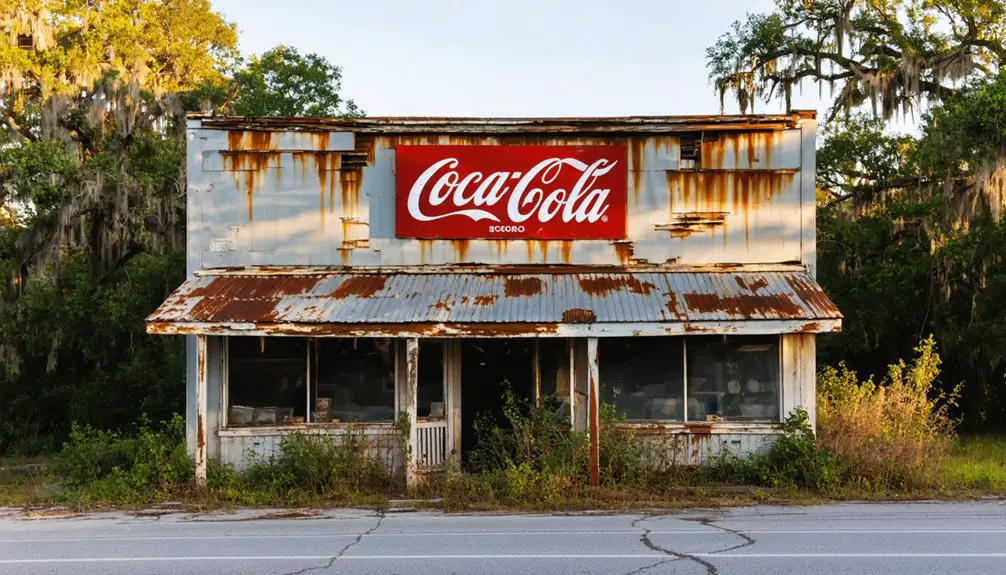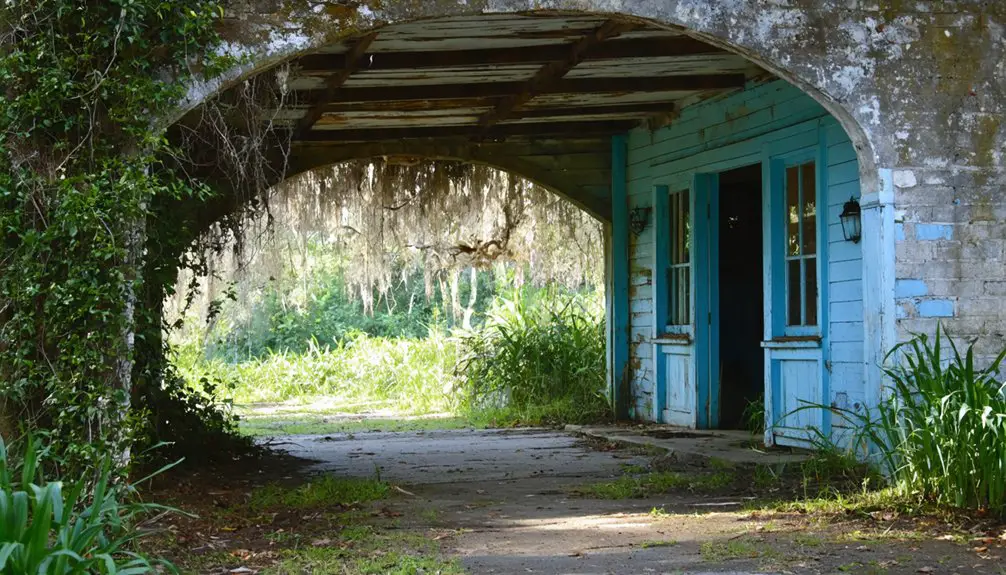You’ll find Bermont’s story in early 1900s Florida, where it flourished as a sawmill settlement during the land boom era. The town thrived on timber processing and sugarcane cultivation, with steam-powered mills and logging railroads driving its economy. Community life centered around baseball games, a debating society, and the local schoolhouse. As the 1920s ended, resource depletion and the Great Depression led to Bermont’s abandonment, though its legacy as a frontier town holds fascinating details about Southwest Florida’s development.
Key Takeaways
- Bermont emerged as a sawmill settlement during Florida’s 1920s land boom, centered around timber processing and sugarcane cultivation.
- The town’s economy relied heavily on its sawmill operations, which featured advanced steam-driven facilities and logging railroad connections.
- Community life flourished with a schoolhouse, general store, post office, and social activities including baseball games and debating societies.
- Economic decline struck when the Florida land bust and Great Depression hit, coupled with depletion of natural resources.
- The town was eventually abandoned as job opportunities dwindled and residents migrated away, leaving it to become a ghost town.
The Rise of a Sawmill Settlement
During the early 1900s land boom in Florida, Bermont emerged as a thriving sawmill settlement in Charlotte County, where timber processing and sugarcane cultivation formed the backbone of its economy.
You’d have found the town’s sawmill technology at the heart of its development, driving the local timber economy and attracting skilled workers to the area.
Like the CH&N railroad line that connected many local settlements, the town’s strategic position near forested areas made it an ideal location for timber harvesting operations.
While unrelated to the French Fort du Bois d’Oye, the town’s strategic position near forested areas made it an ideal location for timber harvesting operations.
Economic Pillars and Local Industries
You’ll find that Bermont’s economic foundation rested firmly on two major industries: the bustling sawmill operations and the extensive sugarcane cultivation.
Like many towns across the Great Plains states, abandoned farming communities became increasingly common as economic conditions deteriorated. The sawmill brought steady employment and attracted workers to the area, while sugarcane agriculture expanded the town’s economic reach through processing and trade networks. Like many frontier settlements that experienced rapid rise and fall, Bermont’s industrial prosperity proved to be short-lived.
These industries worked in tandem to shape Bermont’s growth, with the sawmill clearing land that could then be used for sugarcane farming, creating a symbiotic relationship that briefly sustained the frontier community.
Sawmill Operations Shaped Growth
Three distinct phases marked Bermont’s sawmill-driven development, starting with the town’s establishment during Florida’s 1920s land boom.
You’ll find that sawmill technology evolved from basic water-powered operations to advanced steam-driven facilities, transforming Bermont’s economic landscape through timber cultivation and processing.
- Steam-powered double band saws and chain conveyors revolutionized log processing efficiency
- Concrete log ramps and mill ponds streamlined material handling operations
- Coal-burning powerhouses provided energy for both mill operations and town infrastructure
- Specialized logging railroads connected timber sources to processing facilities
Much like the devastating Curtis sawmill blaze of 1910, the town’s sawmill operations faced constant fire risks that threatened production.
The town’s growth mirrored the broader evolution of Florida’s sawmill industry, as operations expanded from small family-run businesses to larger corporate enterprises, employing more workers and serving wider markets through improved transportation networks.
Weekly reports of mill fires and ignored “No Smoking” signs led to significant economic setbacks in lumber operations throughout the region.
Sugarcane’s Economic Impact
While sawmills shaped Bermont’s early growth, sugarcane cultivation emerged as a powerful economic force that redefined the region’s agricultural landscape.
You’ll find that sugarcane production’s roots trace back to the late 1760s, when British settlers first introduced it near New Smyrna Beach. The industry truly took off after 1900, when drainage of the Everglades created prime farming conditions. The end of Cuban sugar imports in 1960 further accelerated Florida’s commercial sugar production.
Today, you can see the impact of this agricultural evolution across 70,000 acres of fertile Everglades farmland.
The Sugar Cane Growers Cooperative, established in the 1950s, has become a cornerstone of economic sustainability in the region. With 45 grower-owners operating farms of various sizes, the cooperative produces over 350,000 tons of raw sugar annually, supporting local jobs, businesses, and community development through its extensive operations. Their modern Glades Sugar House mill processes an impressive 26,000 tons of sugarcane per day during harvest season.
Daily Life in Early Bermont
You’d find daily life in early Bermont centered around a mix of industrial work at the sawmill and seasonal labor in the sugarcane fields.
When you weren’t working, you might join neighbors at the local baseball games between Bermont and Sparkman or participate in one of the town’s intellectual pursuits through the debating society and literary clubs.
The community gathered regularly at the schoolhouse, which transformed into a church on weekends, making it the heart of both education and religious life. Local historians have preserved many visual resources documenting these community gatherings.
Unlike Fort Dade’s 600 residents, Bermont maintained a smaller, more intimate population that fostered close community bonds.
Community Gatherings and Activities
Despite its modest size, Bermont’s social fabric was woven through a rich tapestry of community organizations and gatherings that defined daily life in the early 1900s.
You’d find social interactions flourishing at the general store and post office, where neighbors exchanged news and caught up on local happenings.
Community events centered around these key activities:
- Baseball games against rival Sparkman that united residents in town pride
- Weekly church services held in the schoolhouse, blending spiritual and social life
- Debating society meetings that sparked civic engagement and public discourse
- Literacy and horticulture club gatherings that fostered learning and agricultural growth
The weekly newspaper kept you informed while clubs and organizations strengthened bonds between families, making Bermont a tight-knit community where everyone played a part.
Work and Social Balance
The rhythms of daily life in early Bermont flowed between the steady hum of sawmill operations and the seasonal demands of sugarcane farming.
You’d find workers rising early for long shifts at the mill, while farmers tended their fields according to nature’s calendar. The town’s work life balance centered around the general store and post office, where you could handle daily business and catch up with neighbors.
Despite the demanding labor dynamics, you’d discover a rich social fabric woven through community activities.
After work, you might join the debating society, cheer for the baseball team, or attend literary club meetings. The school-church building served as your hub for both education and spiritual life, while weekly newspapers kept you connected to local happenings and broader world events.
Cultural Activities and Social Organizations
While many small Florida towns struggled to maintain vibrant social scenes in the early 1900s, Bermont fostered a rich cultural life through its diverse organizations and activities.
You’d find engaged citizens participating in the debating society for lively discussions and the horticulture club for agricultural pursuits.
- Baseball games against rival towns like Sparkman brought the community together for spirited competition.
- Weekly newspaper coverage kept everyone informed about local happenings.
- The schoolhouse served double duty as both an educational center and weekend church.
- A general store and post office created natural gathering spots for daily social interactions.
These social connections weren’t just casual – they formed the backbone of Bermont’s tight-knit community, where you could always find opportunities to learn, socialize, and engage with your neighbors.
The Town’s Gradual Decline

Founded during Florida’s 1920s land boom, Bermont’s dependence on natural resources ultimately led to its downfall. You’d have found a thriving community built around sawmills and sugarcane fields, complete with a post office, general store, and vibrant social clubs.
But the town’s economic vulnerabilities became apparent as the 1920s drew to a close. The Florida land bust and Great Depression hit Bermont hard, while limited railway connections made it difficult to sustain commerce.
As natural resources depleted and job opportunities dwindled, population migration accelerated. You would’ve witnessed the gradual closure of community institutions and the dissolution of local clubs.
Without essential services and facing competition from larger urban centers, Bermont’s remaining residents departed, leaving behind only scattered remnants of what was once a bustling frontier town.
Historical Impact on Southwest Florida
Despite its eventual decline, Bermont’s influence on Southwest Florida extended far beyond its brief existence as a frontier town. The community’s impact sparked significant demographic changes and established essential regional connections through its diverse economic and social contributions.
- You’ll find Bermont’s economic footprint in its thriving lumber industry and sugarcane production, which helped shape the region’s early development during the 1920s land boom.
- The town’s vibrant social scene, including its debating society and baseball team, created lasting connections with neighboring communities like Sparkman.
- Its educational institutions and weekly newspaper fostered intellectual growth and information sharing across Southwest Florida.
- Bermont’s general store and post office established the town as a critical hub for commerce and communication, serving surrounding rural populations.
Frequently Asked Questions
Are There Any Surviving Photographs of Bermont’s Original Buildings and Residents?
Like footprints in sand, original photographs and historical documentation of this community’s buildings and residents are rare. You’ll find very limited surviving images in local archives or private collections.
What Natural Disasters or Environmental Challenges Did Bermont Face During Its Existence?
You’ll find that Gulf Coast hurricanes and flooding posed major threats to Bermont’s survival, damaging the sawmill, disrupting sugarcane farming, and creating infrastructure challenges that likely contributed to its abandonment.
How Did Native American Communities Interact With Bermont’s Early Settlers?
You’ll find Native Americans engaged in cultural exchange with Bermont’s settlers through trade relations, sharing fishing practices and agricultural knowledge, while maintaining semi-autonomous communities despite growing settler populations.
What Were the Average Property Values and Wages in Bermont?
You won’t find exact property trends or wage comparisons from Bermont’s peak, though as a small sawmill town during the 1920s land boom, values stayed modest compared to Florida’s urban centers.
Did Any Notable Historical Figures or Celebrities Ever Visit Bermont?
Like ghost stories that fade into mist, there’s no record of any famous visitors ever coming to your town. Historical records don’t show any celebrities or notable figures stopping by.
References
- https://www.clickorlando.com/features/2024/09/25/floridas-creepiest-ghost-town-is-stashed-on-an-island-heres-the-lowdown/
- https://en.wikipedia.org/wiki/Bermont
- https://www.wikiwand.com/en/articles/Bermont
- https://patchproflorida.com/blog/the-fascinating-history-of-floridas-ghost-towns/
- https://www.ghosttowns.com/states/fl/bermont.html
- https://cchistoricalsociety.com/lost-towns/
- https://newsroom.ocfl.net/2021/10/gone-but-not-forgotten-orange-countys-vanished-communities/
- https://www.southlakechamber-fl.com/history
- https://jrap.scholasticahq.com/api/v1/articles/9543-the-economics-of-ghost-towns.pdf
- https://www.journaloffloridastudies.org/0102ghosttowns.html



